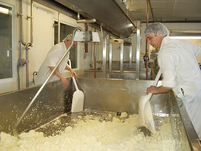Did you know that Bee venom (Apis mellifera) has been used for the treatment of various chronic diseases, such as chronic inflammatory arthritis and chronic liver disease? Heck no I didn't. You learn something every day.

Study Summary:
Alcohol consumption increases apoptosis of hepatocytes. Death of hepatocytes is a characteristic feature of chronic liver disease for various causes. Bee venom (Apis mellifera) has been traditionally used for the treatment of various chronic diseases, such as chronic inflammatory arthritis and chronic liver disease. However, the precise mechanism for bee venom in chronic liver disease is not still cleared. To assess the effects of bee venom in chronic liver disease, we investigated the potential role of the bee venom in the ethanol-induced hepatocyte apoptosis. Bee venom treatment inhibited the apoptotic cell morphology and increased the cell viability in ethanol-induced hepatocyte apoptosis. With ethanol treatment, bee venom-treated hepatocytes increased activity of Bcl-2 and Bcl-xL, reduced activity of Bax, Caspase and PARP. In conclusion, bee venom treatment in ethanol-induced hepatocyte apoptosis occurred through the regulation of Bcl family with subsequent inactivation of the Caspase and PARP. These results suggest that bee venom could be an effective agent to reduce ethanol-induced hepatocyte apoptosis.
Reference
Basic Clin Pharmacol Toxicol. 2010 Mar 4. [Epub ahead of print]
The Protective Effect of Bee Venom against Ethanol-Induced Hepatic Injury via Regulation of the Mitochondria-Related Apoptotic Pathway.
Kim KH, Kum YS, Park YY, Park JH, Kim SJ, Lee WR, Lee KG, Han SM, Park KK.
Department of Pathology, College of Medicine, Catholic University of Daegu, Daegu, Republic of Korea.

 OBJECTIVE: To determine whether lutein supplementation will slow visual function decline in patients with retinitis pigmentosa receiving vitamin A. DESIGN: Randomized, controlled, double-masked trial of 225 nonsmoking patients, aged 18 to 60 years, evaluated over a 4-year interval. Patients received 12 mg of lutein or a control tablet daily. All were given 15,000 IU/d of vitamin A palmitate. Randomization took into account genetic type and baseline serum lutein level.
OBJECTIVE: To determine whether lutein supplementation will slow visual function decline in patients with retinitis pigmentosa receiving vitamin A. DESIGN: Randomized, controlled, double-masked trial of 225 nonsmoking patients, aged 18 to 60 years, evaluated over a 4-year interval. Patients received 12 mg of lutein or a control tablet daily. All were given 15,000 IU/d of vitamin A palmitate. Randomization took into account genetic type and baseline serum lutein level. 



 This effect may be due to differences in the fundamental amino acid composition of the protein (i.e., its amino acid score) and its rate of digestion. Milk proteins, specifically casein and whey, are the highest quality proteins and are quite different in terms of their rates of digestion and absorption. New data suggest that whey protein is better able to support MPS than is soy protein, a finding that may explain the greater ability of whey protein to support greater net muscle mass gains with resistance exercise. This review focuses on evidence showing the differences in responses of MPS, and ultimately muscle protein accretion, to consumption of milk- and soy-based supplemental protein sources in humans.
This effect may be due to differences in the fundamental amino acid composition of the protein (i.e., its amino acid score) and its rate of digestion. Milk proteins, specifically casein and whey, are the highest quality proteins and are quite different in terms of their rates of digestion and absorption. New data suggest that whey protein is better able to support MPS than is soy protein, a finding that may explain the greater ability of whey protein to support greater net muscle mass gains with resistance exercise. This review focuses on evidence showing the differences in responses of MPS, and ultimately muscle protein accretion, to consumption of milk- and soy-based supplemental protein sources in humans. Further adjustment for socio-economic status, alcohol consumption, smoking, maximal oxygen uptake, BMI and the energy-adjusted daily intakes of folate and PUFA did not attenuate this association (relative risk (RR) = 0.23, 95 % CI 0.06, 0.83). No associations were observed between depression and intake of tea (drinkers v. non-drinkers; RR = 1.19, 95 % CI 0.54, 2.23) or caffeine (highest quartile v. lowest quartile; RR = 0.99, 95 % CI 0.40, 2.45). CONCLUSIONS: Coffee consumption may decrease the risk of depression, whereas no association was found for tea and caffeine intake.
Further adjustment for socio-economic status, alcohol consumption, smoking, maximal oxygen uptake, BMI and the energy-adjusted daily intakes of folate and PUFA did not attenuate this association (relative risk (RR) = 0.23, 95 % CI 0.06, 0.83). No associations were observed between depression and intake of tea (drinkers v. non-drinkers; RR = 1.19, 95 % CI 0.54, 2.23) or caffeine (highest quartile v. lowest quartile; RR = 0.99, 95 % CI 0.40, 2.45). CONCLUSIONS: Coffee consumption may decrease the risk of depression, whereas no association was found for tea and caffeine intake. Although in vitro studies of organic fruits and vegetables consistently demonstrate that organic foods have greater antioxidant activity, are more potent suppressors of the mutagenic action of toxic compounds, and inhibit the proliferation of certain cancer cell lines, in vivo studies of antioxidant activity in humans have failed to demonstrate additional benefit. Clear health benefits from consuming organic dairy products have been demonstrated in regard to allergic dermatitis.
Although in vitro studies of organic fruits and vegetables consistently demonstrate that organic foods have greater antioxidant activity, are more potent suppressors of the mutagenic action of toxic compounds, and inhibit the proliferation of certain cancer cell lines, in vivo studies of antioxidant activity in humans have failed to demonstrate additional benefit. Clear health benefits from consuming organic dairy products have been demonstrated in regard to allergic dermatitis. Science Says: As meat is a rich source of the omega-3 fatty acid docosapentaenoic acid (DPA) and Australians consume six times more meat than fish, investigation of the potential health benefit of DPA is warranted. The aims were to compare the effects of seal oil supplementation with fish oil, on measures of plasma lipids and blood pressure in hypertriglyceridaemic subjects. Forty-eight volunteers were recruited from the Wollongong community and were randomly allocated to one of three groups either receiving 1 g/day of long-chain omega-3 polyunsaturated fatty acids (LC n-3 PUFA) using one of three oils: seal oil capsules (340 mg eicosapentaenoic acid (EPA), 230 mg DPA, 450 mg DHA), fish oil capsules (210 mg EPA, 30 mg DPA, 810 mg DHA) or placebo capsules (containing sunola oil) for 6 weeks. Plasma triglycerides remained unchanged in the placebo group, whilst reductions of 7 and 14% (P < 0.05) were seen in the fish oil and seal oil groups respectively. Systolic blood pressure improved by 8 and 5 mmHg with seal oil and fish oil respectively (P < 0.05). The mean arterial pressure was significantly lower after seal oil supplementation (P < 0.005) compared with the placebo group. These results indicate oil in lowering plasma triglycerides and blood pressure.
Science Says: As meat is a rich source of the omega-3 fatty acid docosapentaenoic acid (DPA) and Australians consume six times more meat than fish, investigation of the potential health benefit of DPA is warranted. The aims were to compare the effects of seal oil supplementation with fish oil, on measures of plasma lipids and blood pressure in hypertriglyceridaemic subjects. Forty-eight volunteers were recruited from the Wollongong community and were randomly allocated to one of three groups either receiving 1 g/day of long-chain omega-3 polyunsaturated fatty acids (LC n-3 PUFA) using one of three oils: seal oil capsules (340 mg eicosapentaenoic acid (EPA), 230 mg DPA, 450 mg DHA), fish oil capsules (210 mg EPA, 30 mg DPA, 810 mg DHA) or placebo capsules (containing sunola oil) for 6 weeks. Plasma triglycerides remained unchanged in the placebo group, whilst reductions of 7 and 14% (P < 0.05) were seen in the fish oil and seal oil groups respectively. Systolic blood pressure improved by 8 and 5 mmHg with seal oil and fish oil respectively (P < 0.05). The mean arterial pressure was significantly lower after seal oil supplementation (P < 0.005) compared with the placebo group. These results indicate oil in lowering plasma triglycerides and blood pressure.